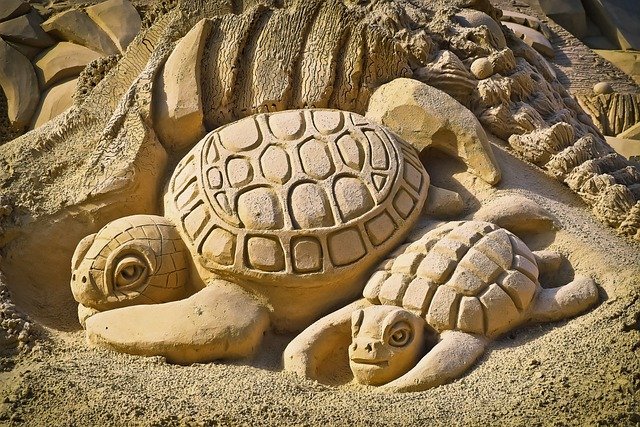The Ephemeral Canvas: Exploring Sand Sculpture Festivals
In a world of fleeting moments and transient beauty, sand sculpture festivals stand as testament to the impermanence of art. These awe-inspiring events bring together artists from across the globe, transforming beaches into temporary galleries of granular masterpieces. As the tides of creativity ebb and flow, we delve into the fascinating world of sand sculpture festivals, uncovering the artistry, challenges, and cultural significance behind these ephemeral wonders.

As the popularity of these events grew, so did the scale and complexity of the sculptures. What once began as simple sandcastles evolved into intricate, larger-than-life creations that push the boundaries of what’s possible with this unique medium. Today, sand sculpture festivals attract millions of visitors annually, showcasing the talents of artists who have mastered the delicate balance between creativity and technical skill.
The Art of Impermanence
At the heart of sand sculpture festivals lies the paradoxical nature of creating art that is destined to disappear. Artists spend days, sometimes weeks, meticulously crafting their sculptures, knowing full well that their creations will eventually succumb to the elements. This inherent impermanence adds a layer of poignancy to the art form, challenging both creators and viewers to appreciate beauty in its most fleeting form.
The process of creating a sand sculpture is as fascinating as the final product. Artists begin by compacting wet sand into large, dense blocks using wooden forms. Once the sand is sufficiently compacted, the real artistry begins. Using a variety of tools - from shovels and trowels to dental picks and straws - sculptors carefully carve away at the sand, revealing intricate details and textures that bring their visions to life.
Global Celebrations of Creativity
Sand sculpture festivals have become global events, with major competitions and exhibitions taking place on beaches and in cities around the world. The International Sand Sculpting Championship in Virginia Beach, USA, attracts master sculptors from over 15 countries, while the Zhoushan International Sand Sculpture Festival in China features massive creations that can reach heights of over 20 meters.
Europe, too, has embraced the art form with enthusiasm. The Søndervig Sand Sculpture Festival in Denmark and the Fiesa International Sand Sculpture Festival in Portugal are renowned for their thematic displays that often incorporate elements of local culture and history. These events not only showcase artistic talent but also serve as cultural exchanges, bringing together diverse perspectives and techniques from around the globe.
Beyond the Beach: Sand Art’s Urban Evolution
While beaches remain the traditional canvas for sand sculpture, the art form has begun to evolve beyond its coastal origins. Indoor sand sculpture exhibitions have gained popularity, allowing for year-round displays and protecting the delicate creations from the whims of weather. These indoor venues often feature climate-controlled environments that can extend the lifespan of sculptures from weeks to months.
Urban sand sculpture festivals have also emerged, transforming city squares and parks into temporary desert landscapes. These events bring the magic of sand art to landlocked communities, often incorporating local landmarks and cultural themes into their displays. The juxtaposition of sand sculptures against urban backdrops creates a surreal and captivating experience for city dwellers and tourists alike.
Environmental Considerations and Sustainability
As awareness of environmental issues grows, sand sculpture festivals have had to grapple with questions of sustainability and ecological impact. The use of large quantities of sand, often imported from other locations, has raised concerns about resource depletion and habitat disruption. In response, many festivals have implemented eco-friendly practices, such as using recycled sand or partnering with local beach restoration projects.
Some artists and organizers have also begun experimenting with alternative materials that mimic the properties of sand but have a lower environmental impact. These innovations not only address ecological concerns but also open up new possibilities for the art form, potentially expanding its reach and longevity.
The Future of Ephemeral Art
As sand sculpture festivals continue to evolve, they face both challenges and opportunities. The COVID-19 pandemic forced many events to adapt, with some turning to virtual exhibitions and online competitions. This digital shift has opened up new avenues for audience engagement and global participation, potentially reshaping the future of sand art festivals.
Looking ahead, the intersection of technology and tradition promises exciting developments for the art form. Augmented reality applications could allow visitors to interact with sculptures in new ways or even preserve digital versions of these temporary masterpieces. 3D printing technologies might enable artists to create more complex and durable structures, further pushing the boundaries of what’s possible with sand as a medium.
Despite these technological advancements, the fundamental appeal of sand sculpture festivals remains rooted in their ephemeral nature. In a world increasingly dominated by the digital and the permanent, these events offer a rare opportunity to appreciate the beauty of impermanence and the value of living in the moment. As we continue to navigate an ever-changing cultural landscape, sand sculpture festivals stand as poignant reminders of the transient nature of art and life itself.




